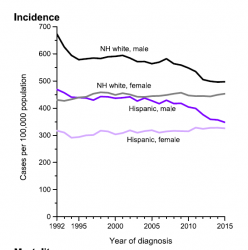Press Releases

October 4, 2018– The cancer burden in Puerto Rico, a U.S. territory with a 99% Hispanic population, is substantially different from that of Hispanics in the continental U.S., according to Cancer Statistics for Hispanics/Latinos, 2018. The report, published every three years, says that men in Puerto Rico have higher prostate and colorectal cancer rates than non-Hispanic whites (NHWs) in the continental U.S, in contrast to U.S. Hispanics as a whole, who have lower rates for these cancers. The report appears in CA: A Cancer Journal for Clinicians.
Prostate cancer is the leading cause of cancer death among men in Puerto Rico, accounting for nearly one in six deaths during 2011-2015, whereas lung cancer accounts for the largest percentage of cancer deaths among other U.S. Hispanic men. Further, Puerto Rico was the only state or territory included in the analysis where lung cancer was not the leading cause of cancer death among men overall. This reflects not only high prostate cancer mortality in the territory (26.7 per 100,000 in Puerto Rico versus 18. 2 in NHWs and 16.2 in other U.S. Hispanics during 2011-2015), but also exceptionally low lung cancer death rates among men in Puerto Rico (19.8 versus 56.3 in NHWs and 26.5 in other U.S. Hispanics). Mortality rates for colorectal cancer in men in Puerto Rico during 2011-2015 were 17% higher than those in NHWs and 35% higher than those of other U.S. Hispanics combined.
These differences highlight the wide variation in cancer risk within the U.S. Hispanic population, for whom population-based health data are often only available in aggregate. Hispanics/Latinos represent the largest racial/ethnic minority group in the United States, accounting for 17.8% (57.5 million) of the continental U.S. population in 2016, including more than one-third of the population in some southern and western states (e.g., California, New Mexico, Texas). An additional three million Hispanic Americans reside in Puerto Rico. The U.S. Hispanic population is one of the most diverse and rapidly growing groups in the U.S. and is expected to nearly double in size by 2060.
Although overall cancer incidence and mortality rates in Hispanics in the continental U.S. and Hawaii are 25% to 30% lower, respectively than in non-Hispanic whites, rates among some U.S.-born Hispanics approach those in non-Hispanic whites. Given that the rapid growth of Hispanic population in the U.S. is now driven by birth rather than immigration, the authors of the report anticipate a burgeoning cancer burden among Hispanics.
Currently, however, the cancer profile in U.S. Hispanics reflects that in Latin America, as one-third of this population is foreign-born and maintains much of the cancer risk of their country of origin. As a group, Hispanics are less likely than NHWs to be diagnosed with the four most common cancers (prostate, breast, lung and bronchus, and colorectal) but have a higher risk of infection-related cancers (stomach, liver, and cervix), which, with the exception of liver cancer, are more frequent in Latin American countries. For example, stomach cancer mortality rates among continental U.S. Hispanics are twice those in NHWs.
Cancer is the leading cause of death among Hispanics, followed by heart disease. In 2018, an estimated 42,700 Hispanic men and women in the US will die from cancer. This does not include cancer deaths in Puerto Rico due to data limitations. Among Hispanic men, lung (16%), liver (12%), and colorectal (11%) cancers cause the most cancer deaths, whereas among women, these are breast (16%), lung (13%), and colorectal (9%) cancers. Lung cancer accounts for 14% of cancer deaths among Hispanics compared to 25% in the overall population because of the historical and continuing low smoking rates in Hispanics. In contrast, liver cancer accounts for 12% of cancer deaths in Hispanic men versus 6% in men overall.
Variations in cancer risk between Hispanics and NHWs, as well as within the Hispanic community, are primarily driven by differences in exposure to cancer-causing infectious agents and behavioral risk factors. For example, the prevalence of cigarette smoking in 2017 was 17% among NHWs compared to 10% among Hispanics residing in the continental US, similar to the rate among island Puerto Ricans; however, within the Hispanic population smoking prevalence ranged from 6% among Dominicans and Central/South Americans to 17% among Puerto Ricans who reside stateside. Counterbalancing generally low smoking rates, continental Hispanics and those in Puerto Rico have among the highest prevalence of the second-most important cancer risk factor – excess body weight—as well as type 2 diabetes, which increases risk independent of body weight.
“Efforts to further progress in cancer control in Hispanics in the U.S., including Puerto Rico, must consider the substantial differences in cancer risk within this heterogeneous population,” write the authors. “Effective strategies for decreasing cancer rates among Hispanics include the use of culturally appropriate lay health advisors and patient navigators; targeted, community-based intervention programs to increase screening and vaccination rates and encourage healthy lifestyle behaviors; and further funding for Puerto Rico–specific and subgroup-specific cancer research and surveillance.”
Article: Cancer Statistics for Hispanics/Latinos, 2018, CA: Cancer J Clin. 2018; doi: 10.3322/caac.21494
URL after embargo: https://onlinelibrary.wiley.com/doi/10.3322/caac.21494
See also: Cancer Facts & Figures for Hispanics & Latinos 2018-2020